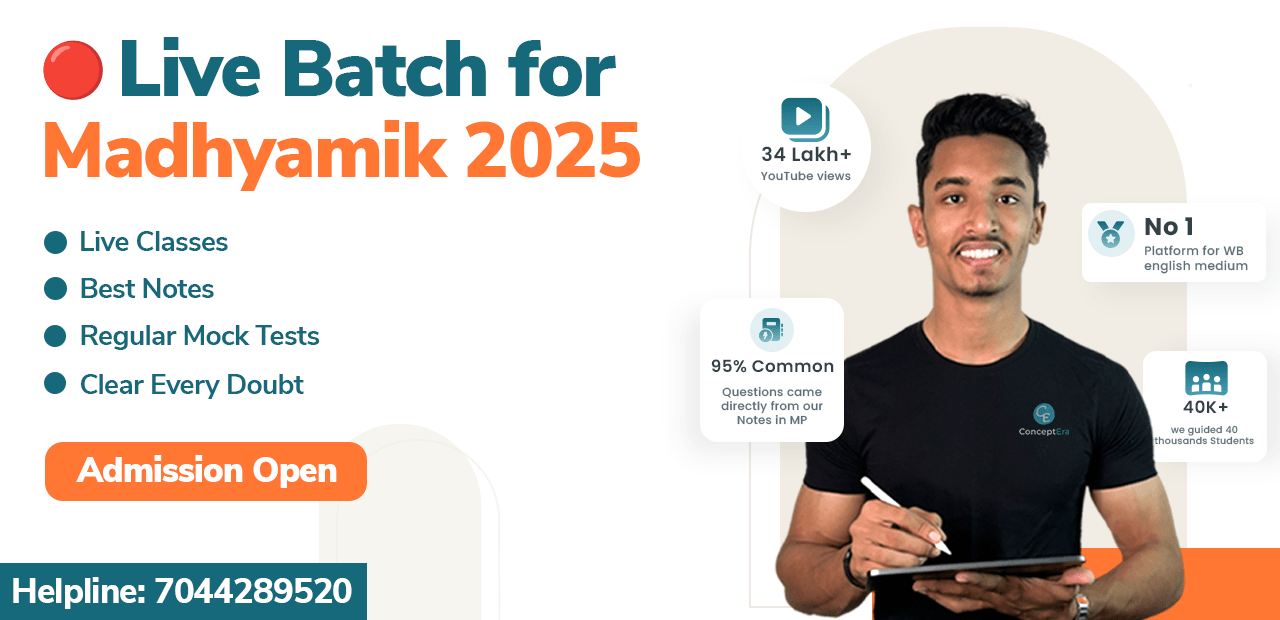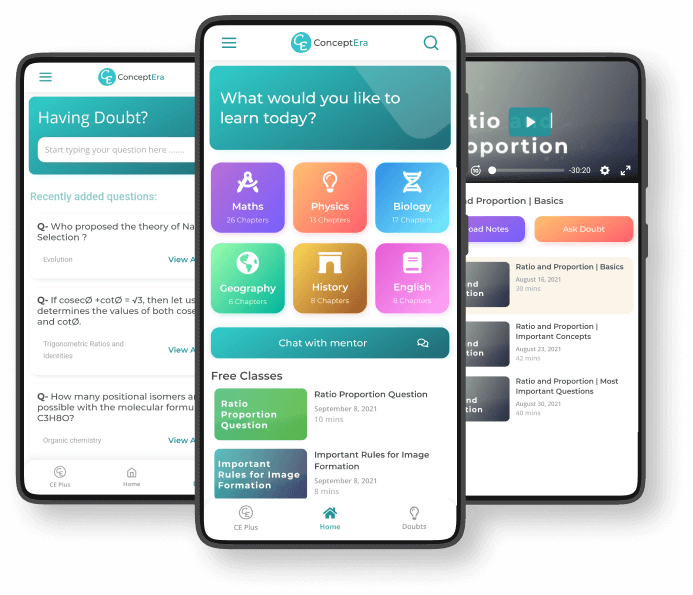Group-A
1. Choose the correct answer.
1.1 Jibaner Jharapata is —
(a) a novel
(b) a book of poems
(c) a biography
(d) an autobiography
1.2 Somprakash was —
(a) a daily paper
(b) a weekly paper
(c) a fortnightly paper
(d) a monthly paper
1.3 The publisher of English Translation of Neeldarpan was —
(a) Kaliprasanna Singha
(b) Michael Madhusudan Dutta
(c) Harischandra Mukhopadhyaya
(d) Rev. James Long
1.4 The practice of Sati was prohibited in —
(a) 1828 AD
(b) 1829 AD
(c) 1830 AD
(d) 1856 AD
1.5 The Ideal of Sarva Dharma Samannwaya was propagated by —
(a) Bijoy Krishna Goswami
(b) Swami Vivekananda
(c) Sri Ramakrishna
(d) Keshab Chandra Sen
1.6 ‘Kol’ rebellion (1831-32) took place in —
(a) Medinipur
(b) Jhargram
(c) Chhotonagpur
(d) Ranchi
1.7 The First Forest Act was passed in India in —
(a) 1859 AD
(b) 1860 AD
(c) 1865 AD
(d) 1878 AD
1.8 The Revolt of 1857 was described as India’s First War of Independence by —
(a) Rameshchandra Mazumdar
(b) Surendranath Sen
(c) Binayak Damodar Savarkar
(d) Dadabhai Nauroji
1.9 The rule of East-India Company in India came to an end in —
(a) 1857 AD
(b) 1858 AD
(c) 1819 AD
(d) 1847 AD
1.10 First President of Indian Association was —
(a) Surendranath Bandyopadhyaya
(b) Anandamohan Bose
(c) Rev Krishnamohon Bandyopadhyaya
(d) Sibnath Sastri
1.11 The first printed book in Bengali Language was —
(a) Barnaparichay
(b) A Grammar of Bengali Language
(c) Mangal Samachar Matier
(d) Annadamangal
1.12 The scientist of the Indian Association for the Cultivation of Science who was awarded Nobel prize was —
(a) Jagadishchandra Bose
(b) C V. Raman
(c) Prafulla Chandra Roy
(d) Satyendranath Bose
1.13 The Boycott movement economically affected —
(a) Peasants of Bengal
(b) Middle Class
(c) Zamindars
(d) Students
1.14 Baba Ramchandra led peasants movement in —
(a) Bihar
(b) United Province
(c) Rajasthan
(d) Maharashtra
1.15 Rampa Tribal rebellion was organised in—
(a) Malabar region
(b) Konkon Coastal area
(c) Orissa
(d) Godavari Valley
1.16 ‘Nari Karma Mandir’ was established by—
(a) Urmila Devi
(b) Basanti Devi
(c) Kalpana Dutta
(d) Leela Roy (Nag)
1.17 The revolutionary group founded by Surya Sen was known as—
(a) Anushilan Samity
(b) Gadar Dal
(c) Indian Republican Army
(d) Bengal Volunteers
1.18 Dalits were called ‘Harijan’ by—
(a) Jyotiba Phule
(b) Narayan Guru
(c) Gandhiji
(d) Dr. Ambedkar
1.19 Separate linguistic state of Andhra Pradesh was formed in the year—
(a) 1947 AD
(b) 1950 AD
(c) 1953 AD
(d) 1955 AD
1.20 Goa became a part of India in—
(a) 1947 AD
(b) 1956 AD
(c) 1961 AD
(d) 1971 AD
Group-B
2. Answer the following questions:
(Attempt one question from each sub-group, in all answer 16 questions):
Sub-group—2.1
Answer each of the following questions in one sentence:
2.1.1 In which historical context the ‘Bharatmata’ was painted ?
2.1.2 Where was founded the All India Trade Union Congress (1920) ?
2.1.3 In which year was the Forward Bloc founded ?
2.1.4 Who is the founder of the Matua Community ?
Sub-group—2.2
Identify which of the following is ‘True’ or ‘False’:
2.2.1 Uday Shankar encouraged educated middle class Bengalees in dance.
2.2.2 Indian Association protested against the Ilbert Bill.
2.2.3 Faraji is the name of an ancient tribe.
2.2.4 Vidyasagar introduced Lino type in Bengali.
Sub-group—2.3
Match Column ‘A’ with Column ‘B’:
| Column A | Column B |
|---|---|
| 2.3.1) Jawaharlal Nehru | (1) Non co-operation movement |
| 2.3.2) Birendranath Sashmal | (2) Poona Pact (1932) |
| 2.3.3) Kaliprasanna Singha | (3) “Letters from a Father to his Daughter” |
| 2.3.4) Dr. Ambedkar | (4) Hutom Pyanchar Naksha |
Sub-group—2.4
On the given outline map of India, locate and lebel the following places:
2.4.1 Areas of Chuar Rebellion,
2.4.2 Region of Munda Rebellion,
2.4.3 Centre of 1857 Revolt—Jhansi,
2.4.4 Princely State—Junagarh.
Sub-group—2.5
Select the correct interpretation of the following statements:
2.5.1 Statement: Nineteenth century Bengal Renaissance was limited in scope.
Interpretation-1: Because only rural Bengal experienced it.
Interpretation-2: Because this renaissance was limited to the field of literature.
Interpretation-3: Because this renaissance was limited to western educated progressive society.
2.5.2 Statement: The British Govt, passed the Act-Ill in 1872.
Interpretation-1: Its object was to unite the Hindu, Muslim and Christian Communities.
Interpretation-2: Its object was to develop the economic, social and cultural development of the people.
Interpretation-3: Its object was to ban child marriage and polygamy and also to legalise widow re-marriage.
2.5.3 Statement: Rabindranath didn’t like the colonial system of education.
Interpretation-1: Because this system was expensive.
Interpretation-2: Because the medium of instruction was vernacular.
Interpretation-3: Because this system did not help the mental development of the student.
2.5.4 Statement: Sarala Devi Chowdhurani established Lakshmir Bhandar.
Interpretation-1: To sale foreign goods.
Interpretation-2: To help woman who were engaged in movements.
Interpretation-3: To sale indigenous goods.
Group—C
3. Answer the following questions in two or three sentences only (any eleven):
3.1 What is the importance of history of environment ?
3.2 How are memoirs or autobiographies used as sources of modern Indian history ?
3.3 What is Macaulay’s Minute ?
3.4 What was the role of Young Bengal in social reform ?
3.5 Why is Dudu Mian remembered ?
3.6 What was the role of Harishchandra Mukhopadhyay in the Indigo Revolt ?
3.7 What was the main objective of the Queens Proclamation (1858) ?
3.8 With what purposes are Cartoons drawn ?
3.9 What was the role of Panchanan Karmakar in the development of the printing press in Bengal ?
3.10 What is the importance of the Battala publications in the history of the Bengali printing press ?
3.11 Why was the ‘Eka’ movement initiated ?
3,12 Why was the Bardauli Satyagraha movement organised ?
3.13 With what objective was the Anti-Circular Society founded ?
3.14 Why was the Dipali Sangha established ?
3.15 Under what circumstances Hari Singh, the ruler of Kashmir signed the instrument of Accession ?
3.16 Why was the States Reorganisation Commission (1953) formed ?
Group—D
4. Answer the following questions in seven or eight sentences each.
(Attempt one question from each Sub-group. Answer six questions in all):
Sub-group—D.1
4.1 What picture of 19th century Bengalee society is revealed in the book “Hutom Pyanchar Naksha” ?
4.2 What role did the Calcutta Medical College play in the field of medical science in this country ?
Sub-group—D.2
4.3 With what objectives the Colonial Government enacted the Forest Laws ?
4.4 Can the Great Revolt of 1857 be termed as a feudal revolt ?
Sub-group—D.3
4.5 What was the contribution of Ganga Kishore Bhattacharyya in the growth of Bengali printing press ?
4,6 How did the Serampore Mission Press develop into a front ranking printing press ?
Sub-group—D.4
4.7 Write a short note on the Refugee Problem in India after Partition (1947).
4.8 How was the princely state of Hyderabad incorporated into India ?
Group—E
5. Answer any one question in fifteen or sixteen sentences:
5.1 What was the role of the various Brahmo Samajas in the movement for social reform in the nineteenth century Bengal ?
5.2 Briefly discuss the ideas of Rabindranath Tagore on the synthesis between Nature, Man and Education.
5.3 Discuss the role of the Leftists in the Anti Colonial Movements of 20th Century India.

